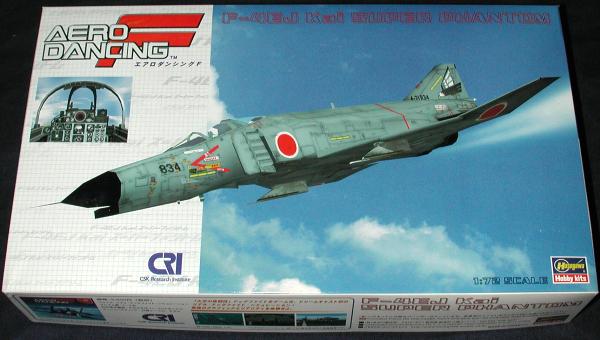
|
KIT: |
Hasegawa 1/72 F-4EJkai Phantom II |
|
KIT # |
GC 5 |
|
PRICE: |
¥ 1800 |
|
DECALS: |
One aircraft |
|
REVIEWER: |
|
|
NOTES: |
#5 in the 'Aero Dancing' series |

|
BACKGROUND |
Though it doesn't happen very often, I've been seeing more 'mainstream' kits being reissued to tie in with other areas of entertainment in the last few years. One of these is the Area 88 kits similar to that previewed recently. In that case it corresponds with a very popular anime or cartoon series that involves modern aircraft. This other series is entitled 'Aero Dancing' and is hooked in with a computer game where the player gets to fly various types of aircraft.
Unlike the Area 88 kit which was strictly Japan only, this series is more widely distributed and includes instructions in English. In fact, except for the box art and the decal sheet, there is no difference between this particular kit and any other Hasegawa F-4E, regardless of variant.
|
THE KIT |

The image of the sprues shows those areas of the F-4E kit that are different from the Navy F-4B/N/J/S kits. In fact, with this kit, you can build any F-4E from the very early Vietnam era gun Phantoms to the latest Japanese F-4EJkai. All of the different parts to do these versions are included in with the kit as there are multiple fin tip and gun nose variations as well as the different parabrake housings for each type. You have a choice of slatted or unslatted wings and two different centerline tanks are given; both early and the later F-15 type.
However all these options comes with a price and that is that the kit is quite fiddly with many small parts. What it means to you as a builder is that you have to take your time and carefully fit all of these pieces in place. Just to give a brief rundown, you get finely engraved panel lines, a full cockpit though the instruments are decals (typical of many 1/72 kits and almost all of the Hasegawa ones), and no weapons. For those you'll need to spend the bucks on the required Hasegawa weapons set or scrounge them from your spares box.
Instructions are the usual superb Hasegawa ones giving Gunze paint references as well as FS numbers where they are required. The decal sheet (not shown) offers only one option and that is what is shown on the box top. There are the usual plethora of data markings that are still on Japanese Phantoms. The camouflage is a pseudo-F-15 sort of scheme with FS 36320 uppers and FS 36375 lower surfaces. The tail markings are very much like those of 302 squadron though the serial presentation is a bit odd as there are usually two digits prior to the hyphen in modern JASDF serials.
|
CONCLUSIONS |
Regardless of the boxing, the Hasegawa F-4 family is still the best you can get in 1/72. The Fujimi's are easier to build, but the detail level is just a bit higher in the Hasegawa kits. Those concerned about the odd markings have no worry as there are PLENTY of aftermarket sheets for this aircraft. The really nice thing is that this kit is many hundreds of yen cheaper than the 'normal' Hasegawa Phantoms. If you can find them, they are worth the effort to pick up.
Review kit courtesy of my kit collection.
If you would like your product reviewed fairly and quickly by a site that has well over 100,000 visitors a month, please contact me or see other details in the Note to Contributors.